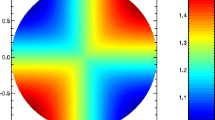Abstract
All four giant planets in the solar system possess irregular satellites, characterized by large, highly eccentric and/or highly inclined orbits. These bodies were likely captured from heliocentric orbit, probably in association with planet formation itself. Enabled by the use of large-format digital imagers on ground-based telescopes, new observational work has dramatically increased the known populations of irregular satellites, with 74 discoveries in the last few years. A new perspective on the irregular satellite systems is beginning to emerge.We find that the number of irregular satellites measured to a given diameter is approximately constant from planet to planet. This is surprising, given the radically different formation scenarios envisioned for the gas giants Jupiter and Saturn compared to the (much less massive and compositionally distinct) ice giants Uranus and Neptune. We discuss the new results on the irregular satellites and show how these objects might be used to discriminate amongst models of giant planet formation.
Similar content being viewed by others
References
Beauge, C., Roig, F., and Nesvorny, D.: 2002, ‘Effects of planetary migration on natural satellites of the outer planets’, Icarus 158, 483–498.
Boss, A.: 1997, ‘Giant planet formation by gravitational instability’, Science 276, 1836–1839.
Boss, A.: 2003, ‘Rapid formation of outer giant planets by disk instability’, Astrophys. J. 599, 577–581.
Colombo, G. and Franklin, F.: 1971, ‘On the formation of the outer satellite groups of Jupiter’, Icarus 15, 186–189.
Cuk, M. and Burns, J.: 2003, ‘Gas-drag-assisted capture of Himalia’s family’, Icarus 167, 369–381.
Dohnanyi, J.S.: 1969, ‘Collisional model of asteroids and their debris’, J. Geophys. Res. 74, 2431–2554.
Gladman, B.J., Nicholson, P.D., Burns, J.A., Kavelaars, J.J., Marsden, B.G., Williams, G.V., and Offutt, W.B.: 1998, ‘Discovery of two distant irregular moons of Uranus’, Nature 392, 897–899.
Gladman, B., Kavelaars, J.J., Holman, M., Petit, J.-M., Scholl, H., Nicholson, P., and Burns, J.A.: 2000, ‘The discovery of Uranus XIX, XX, and XXI. Discovery of 12 satellites of Saturn exhibiting orbital clustering’, Icarus 147, 320–324.
Gladman, B., et al.: 2001, ‘Discovery of 12 satellites of Saturn exhibiting orbital clustering’, Nature 412, 163–166.
Grav, T., Holman, M., Gladman, B., and Aksnes, K.: 2003, ‘Photometric survey of the irregular satellites’, Icarus 166, 33–45.
Heppenheimer, T.A. and Porco, C.: 1977, ‘New contributions to the problem of capture’, Icarus 30, 385–401.
Holman, M.J., et al.: 2004, ‘Discovery of five irregular moons of Neptune’, Nature 430, 865–867.
Jewitt, D., Sheppard, S., and Porco, C.: 2004, ‘Jupiter’s outer satellites and Trojans’, in F. Bagenal, T. Dowling and W. McKinnon (eds.), Jupiter, Cambridge Univ. Press, England.
Kuiper, G.P.: 1956, ‘On the origin of the satellites and the Trojans’, Vistas in Astronomy 2, 1631–1666.
Nakamura, T. and Yoshikawa, M.: 1995, ‘Close encounters and collisions of short-period comets with Jupiter and its satellites’, Icarus 116, 113–130.
Nesvorny, D., Alvarellos, J., Dones, L., and Levison, H.: 2003, ‘Orbital and collisional evolution of the irregular satellites’, Astron. J. 126, 398–429.
Pollack, J.B., Burns, J.A., and Tauber, M.E.: 1979, ‘Gas drag in primordial circumplanetary envelopes: a mechanism for satellite capture’, Icarus 37, 587–611.
Pollack, J., Hubickyj, O., Bodenheimer, P., Lissauer, J., Podolak, M., and Greenzweig, Y.: 1996, ‘Formation of the giant planets by concurrent accretion of solids and gas’, Icarus 124, 62–85.
Rettig, T., Walsh, K., and Consolmagno, G.: 2001, ‘Implied evolutionary differences of the Jovian irregular satellites from a BVR color survey’, Icarus 154, 313–320.
Sheppard, S. and Jewitt, D.: 2003, ‘An abundant population of small irregular satellites around Jupiter’, Nature 423, 261–263.
Sheppard, S. and Jewitt, D.: 2004, ‘Ultradeep survey for irregular satellites of Uranus: limits to completeness’, Astron. J., in press.
Thommes, E., Duncan, M., and Levison, H.: 1999, ‘The formation of Uranus and Neptune in the Jupiter-Saturn region of the Solar System’, Nature 402, 635–638.
Weidenschilling, S.: 2002, ‘On the origin of binary Transneptunian objects’, Icarus 160, 212–215.
Author information
Authors and Affiliations
Corresponding author
Rights and permissions
About this article
Cite this article
Jewitt, D., Sheppard, S. Irregular Satellites in the Context of Planet Formation. Space Sci Rev 116, 441–455 (2005). https://doi.org/10.1007/s11214-005-1965-z
Received:
Accepted:
Issue Date:
DOI: https://doi.org/10.1007/s11214-005-1965-z




